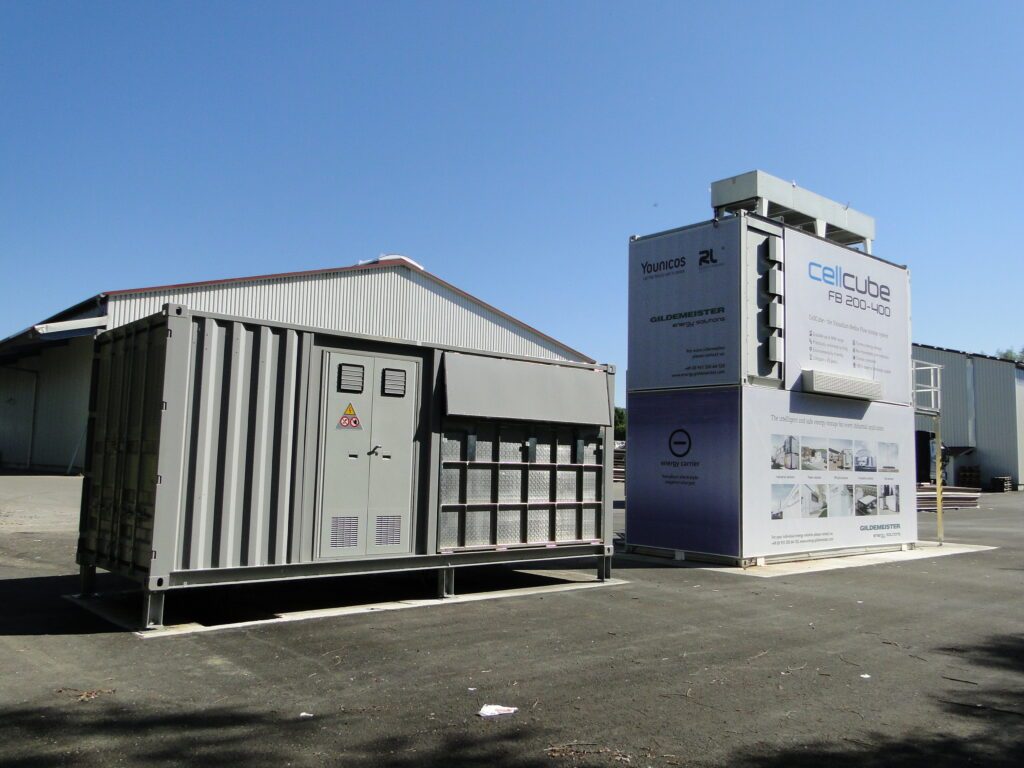Smart Power Flow

Project description
Relieve the distribution network
In this project, for the first time of a large scale stationary redox-flow battery (CellCube FB200-400 DC) of the company Gildemeister energy solutions has been integrated into a distribution grid in order to reinforce an electrical network with a high share of renewable energies. The main goal was to quantify which network expansion measures can be avoided through the usage of battery storage systems and to what extent.
Analysis and optimization
The main objectives of the project were the technical and economic analysis and optimization of network expansions and usage of local energy storage systems. As part of the project, a redox-flow storage of the company Gildemeister energy solutions was integrated into the distribution network and adapted to a new demand profile, due to the rapid increase of renewable energies. The most important intermediate steps were: identification of network characteristics for achieving an effective optimization of network expansion versus the implementation of decentralized energy storage systems; development of battery inverters for 200 kW DC / 500kVA redox-flow batteries; demonstration and confirmation of the analytically identified network optimization measures.
A simulation was developed to determine the optimal placement of big stationary batteries within distribution grids with high shares of renewable energies. The aim of the model was to facilitate a wide-scale mentation of stationary batteries into the German electrical grid.
Realization in three steps
Phase 1: Optimization of the location of a redox flow battery in the grid of LVN (LEW Verteilnetz GmbH) by using simulation tools; development of a battery inverter (first year)
Phase 2: Integration of the battery into the grid of LVN and validation of the simulation models by using measured data (second year)
Phase 3: Development of a concept for the integration of large battery storage systems into distribution grids; technical and economical evaluation of grid extension versus integration of battery systems into the distribution grid (third year).
Results
Ergebnis 1: Das von den Projektpartnern entwickelte Batteriesystem wurde in einer einjährigen Testphase im Feld erprobt. Anhand von Messdaten war es möglich den Batterieprototyp sowie das lokale Stromnetz zu modellieren und damit eine optimale Betriebsstrategie für den Speicher zu entwickeln. Diese wurde im Feldtest bestätigt.
Ergebnis 2: Für einen technischen und wirtschaftlichen Vergleich des Batterieeinsatzes mit anderen Flexibilisierungsoptionen, welche in diesem Projekt die cosφ(P)- und Q(U)-Regelung von Photovoltaiksystemen sowie den Einsatz von Heimspeichern umfassten, wurde ein zukünftiger Photovoltaik-Ausbaupfad für den Installationsort erstellt. Dieser basiert auf der Identifikation geeigneter Dachflächen für Solarsysteme unter Verwendung von Luftaufnahmen. Es wurde gezeigt, dass die Netzaufnahmefähigkeit für Erneuerbare Energieanlagen in allen Fällen gegenüber dem Szenario ohne Flexibilisierungsoptionen steigt, teils um bis zu 45 %.
Ergebnis 3: Aus Perspektive der Netzbetreiber ist es ökonomisch sinnvoll, jede der untersuchten Optionen dem konventionellen Netzausbau vorzuziehen.